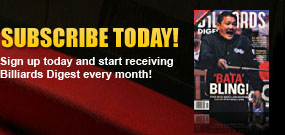By George Fels
[Reprinted from February 2001]
Many of us, when young, briefly pursue a fantasy about being invisible, even if for no more noble purpose than entering girls’ locker rooms or robbing banks. But the closest most of us will ever come to attaining that low a profile will be to referee a pool match.
One of the best sports quotes of the ’80s came from a major league umpire who averred, “In my profession, the highest accolade is silence.” At least a baseball umpire has to be in place, or a game cannot proceed. Exactly how lowly a figure does that make of the cue games ref, when the lion’s share of both players and spectators wish he weren’t there at all?
The very first billiards match of consequence was played in Detroit for an astonishing $10,000 by Michael Phelan, who was first in virtually every aspect of the cue games, and hometowner John Seerey. Pheland (who won) would go on to become the first (what else is new?) referee to whom anyone paid any attention, because of his playing greatness, and he also instated the policy of inviting playing legends to serve as referee as an honor. Later, Willie Hoppe would similarly call on Charlie Peterson at every turn, and Willie Mosconi, who never lost a single challenge match in Kansas City, always specified Bennie Allen as his ref of choice.
To the uninitiated, it appears that a referee’s principal duty is to instruct the scorekeepers what numbers to post, a duty made even drearier in today’s 9-ball world where no score is kept except by game, one point at a time. But experts, of course, recognize that the ref must be an expert himself, on both the game and the way it is played, although he need not be an expert player personally.
When the BCA resuscitated the U.S. Open 14.1 Tournament in the mid-’60s, the preeminent referee of that game was a gnome-like little man named “Cue Ball Kelly, who was about as Irish as Jimmy Durante. Kelly’s real name was Carl Zingale. Whatever his ethnicity, Kelly had visibility as a ref because he was from the East Coast, whose players’ superiority at the game was well-established, and tournament promoters were simply used to having him around. Not all players rushed to share in the adulation; many felt he was vastly overrated, and at one Open, Brooklyn’s Johnny Ervolino had to be restrained from starting a fist fight after Kelly called an object-ball foul which apparently only he saw.
Thus, something of a gap existed in referencing leadership, and Conrad Burkman, a Detroit credit report marketing executive with an honest-to-goodness flat-top crewcut, rushed to fill it. Burkman’s personal inspiration for getting into the field in the first place was the third prominent ref of the era, retired hustler Maurice “Tugboat” Whaley. The moniker came from Whaley’s posing as a retired tugboat captain, as part of his hustler’s front; his peers not so quietly questioned Whaley’s ability to man a canoe, but no matter, he got plenty of refereeing gigs too. One of these was the old hustler’s jamborees in Johnston City, Ill., and in 1963 Burkman saw his first professional match; it was a good one, too, 9-ball between the late Luther Lassiter and the late Harold Worst, refereed, if one could call it that, by Whaley. Under the rules of that period, the incoming player was awarded a re-spotted ball and a spot shot, not ball in hand, following an opponent’s scratch. Thus, Worst’s scratch on the 8 was not an automatic guarantee of victory, although the way Wimpy was playing, it was pretty close.
“’Boat. ‘Boat!” Lassiter bellowed for his referee. The match was being played in a sunken, amphitheater-like arena, and alleged referee Whaley was found not on the tournament floor but in the first row of spectators, greedily munching on a hot dog. He hurriedly re-spotted the 8 for Wimpy’s spot shot, with as much dignity as possible. Lassiter then fired the ball in — and left a clear trail of mustard on the pristine new green cloth from the spot all the way to the pocket.; Whaley had not even bothered to wipe his hands. Somehow, at that moment, Conrad Burkman knew what he wanted to do with his life.
Burkman would go on to initiate what became time-limit rules; after witnessing one player loaf through a five-hour straight pool match in a desperate attempt to sober up, he insisted that the BCA install sportsmanship rules against stalling. He then became the first to enforce such a rule, the first year the U.S. Open 14.1 went to Dayton, Ohio, in a match between noted dawdlers Tom Jennings of New Jersey and Richard Lane of Texas. The two had taken nearly 3 ˝ hours to bring the score to something like 80-56; Jennings had just scratched, leaving Lane a closed 15-ball rack. With everyone in the gallery fully aware that Lane was going to take an intentional scratch in return, Lane nevertheless circled the table a full dozen times, perhaps absorbed in the rack’s symmetry. Referee Burkman had had enough, and, producing a stopwatch with a flourish, announced, “You have 60 seconds to put that cue ball into motion.” The game was completed in less than 30 minutes.
He also may have created a new category of foul. Kansas City’s Donna Ries, a former intercollegiate champion, paid the penalty for being both too shapely and too low in her stance. Bending to the table, she brought her bosom to the 8 ball as surely as if it were Cleopatra’s asp, and referee Burkman unembarrassedly shouted, “Foul!”
“Where?” gasped the bewildered Ries.
“Darlin’,” explained Burkman, with dazzling political incorrectness, “You just laid your left one on the 8.”
It’s a, well, touchy business.





